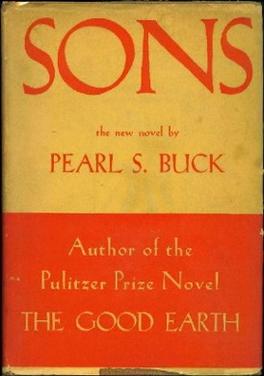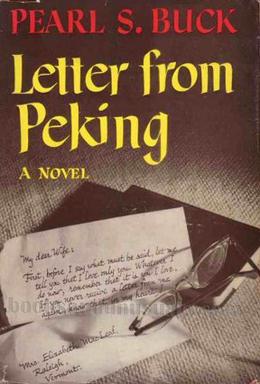
The Good Earth is a 1937 American drama film about Chinese farmers who struggle to survive. It was adapted by Talbot Jennings, Tess Slesinger, and Claudine West from the 1932 play by Owen Davis and Donald Davis, which was in itself based on the 1931 novel of the same name by Nobel Prize-winning author Pearl S. Buck. The film was directed by Sidney Franklin, with uncredited contributions by Victor Fleming and Gustav Machaty.

Pearl Comfort Sydenstricker Buck was an American writer and novelist. She is best known for The Good Earth, the best-selling novel in the United States in 1931 and 1932 and which won her the Pulitzer Prize in 1932. In 1938, Buck became the first American woman to win the Nobel Prize in Literature "for her rich and truly epic descriptions of peasant life in China" and for her "masterpieces", two memoir-biographies of her missionary parents.

The Good Earth is a historical fiction novel by Pearl S. Buck published in 1931 that dramatizes family life in a 20th-century Chinese village in Anhwei. It is the first book in her House of Earth trilogy, continued in Sons (1932) and A House Divided (1935). It was the best-selling novel in the United States in both 1931 and 1932, won the Pulitzer Prize for Fiction in 1932, and was influential in Buck's winning the Nobel Prize for Literature in 1938. Buck, who grew up in China as the daughter of American missionaries, wrote the book while living in China and drew on her first-hand observation of Chinese village life. The realistic and sympathetic depiction of the farmer Wang Lung and his wife O-Lan helped prepare Americans of the 1930s to consider Chinese as allies in the coming war with Japan.

Yan Poxi is a fictional Song dynasty woman from the Chinese novel Water Margin. She is usually called Yan Xijiao, a Hua Dan, in Chinese opera.

"East of the Sun and West of the Moon" is a Norwegian fairy tale. It was included by Andrew Lang in The Blue Fairy Book (1889).

"The Singing, Springing Lark", "The Singing, Soaring Lark", "The Lady and the Lion" or "Lily and the Lion" is a German fairy tale collected by the Brothers Grimm, appearing as tale no. 88.

Sons is a historical fiction novel by American author Pearl S. Buck first published by John Day Company in 1932. It is the second book in The House of Earth trilogy, preceded by The Good Earth and followed by A House Divided.

A House Divided is a historical fiction novel by American author Pearl S. Buck first published by John Day Company in 1935. The story centers on the third generation of Wang Lung's family, focusing particularly on his grandson Wang Yuan. It is the third and final book in The House of Earth trilogy, preceded by Sons.
American Girl introduced the Girls of Many Lands series in 2002. Each story is about a 12-year-old girl living in a different time period in different parts of the world. The books, written by award-winning authors, originally came with a matching doll intended for display. The series was discontinued in 2005 and the dolls have become a popular collectible item.

Letter from Peking is a 1957 novel by Pearl S. Buck. The story is about a loving interracial marriage between Gerald and Elizabeth MacLeod, their separation due to the communist uprising in China in 1949, and their separate lives in China and America.

A Countess Below Stairs is a 1981 British historical romance novel by Eva Ibbotson. It follows the story of Anna Grazinsky, a Russian countess, after World War I. It has also been published under the title The Secret Countess as a young adult novel.
Pembroke (1894) is a novel written by Mary E. Wilkins Freeman. It is set in the small town of Pembroke, Massachusetts in the 1830s and 40s. The novel tells the story of a romance gone awry and the dramatic events that follow, which entertain the residents of the small town for years after. As one of Freeman's first novels, Pembroke experienced great success in its time and, although it has only recently experienced a comeback in the academic sphere, it is known for being an exemplary piece of New England local color fiction.

Prince of Lan Ling is a 2013 Chinese television series that is set during the lifetime of the Northern Qi Dynasty prince Gao Changgong. It starred Chinese actor Feng Shaofeng as the titular Prince of Lan Ling, alongside Taiwanese actress singer Ariel Lin and Hong Kong actor singer Daniel Chan.

The Love Eterne is a 1963 Hong Kong musical film of the Huangmei opera genre directed by Li Han Hsiang. An adaptation of the classic Chinese story "Butterfly Lovers", it tells of the doomed romance between the male Liang Shanbo and the cross-dressed female Zhu Yingtai.

Lovers Courageous is a 1932 American pre-Code drama film directed by Robert Z. Leonard and written by Frederick Lonsdale. The film stars Robert Montgomery, Madge Evans, Roland Young, Frederick Kerr, Reginald Owen and Beryl Mercer. The film was released on January 23, 1932, by Metro-Goldwyn-Mayer.

Christine is a musical by Pearl S. Buck and Charles K. Peck Jr. (book), Paul Francis Webster (lyrics) and Sammy Fain (music). Loosely based on the 1945 novel My Indian Family by Hilda Wernher, it tells the story of a woman who travels to India where she ends up falling in love with her recently widowed Indian son-in-law. Notable for the involvement of Pulitzer & Nobel prize winning author Pearl S. Buck, the musical premiered on Broadway in 1960.

The 1938 Nobel Prize in Literature was awarded to the American author Pearl S. Buck (1892–1973) "for her rich and truly epic descriptions of peasant life in China and for her biographical masterpieces." Buck was the first female American to be awarded the Nobel Prize and the third American recipient following Eugene O'Neill in 1936 and Sinclair Lewis in 1930. She was also the fourth woman to receive the prize.
Again, The Snake Bridegroom is a Serbian folktale collected in the 19th century by Serbian philologist Vuk Karadžić, featuring the marriage between a human maiden and a husband in serpent guise.
Princess Aubergine is an Indian folktale collected by Flora Annie Steel and sourced from the Punjab region. It concerns a princess whose lifeforce is tied to a necklace, and, as soon as it falls in the hand of a rival, the princess falls into a death-like sleep - comparable to heroines of European fairy tales Snow White and Sleeping Beauty. Variants exist in India, both with a heroine and a hero whose life is attached to a magical necklace.














